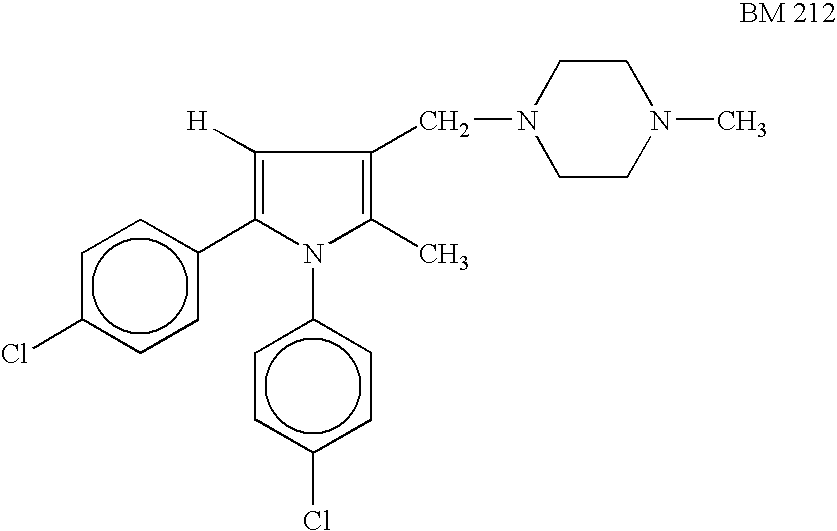Pyrrole derivatives as antimycobacterial compounds
a technology of pyrrole derivatives and mycobacterial compounds, which is applied in the direction of biocide, plant growth regulators, animal husbandry, etc., can solve the problems of comparatively difficult control, failure of treatment, and non-compliance of patients, and achieve the effect of low toxicity
- Summary
- Abstract
- Description
- Claims
- Application Information
AI Technical Summary
Benefits of technology
Problems solved by technology
Method used
Image
Examples
example-1
Preparation of 1-([1,5-bis(4-chlorophenyl)-2-methylpyrrol-3yl]methyl}-4-(3-trifluoro-methylphenyl)piperazine (Compound No.3 of Formula I) as per Method-I
Step 1: 1-(4-chlorophenyl)pentane-1,4-dione
[0221] To a well stirred suspension of anhydrous aluminium chloride (29.66 gm, 0.223 mol) in 154.7 ml. of chlorobenzene was added 4-oxopentanoylchloride (25.0 gm, 0.187 mol) drop-wise, over a period of 30-35 minutes at room temperature (25-30° C.). The reaction mixture was stirred at the same temperature for 1 hour. After decomposition of the reaction mixture by the addition of solid ice and hydrochloric acid (10 ml) the precipitated solid was filtered and filtrate was concentrated in a rotary evaporation to remove all the solvents. The residue was dissolved in ethyl acetate (400 ml.), washed with water (2×100 ml.), brine (100 ml.). The organic layer was dried over anhydrous sodium sulfate and the solvent evaporated off. The crude product so obtained was chromatographed over silica gel (1...
example-2
Preparation of N-(3-{[4-(3-trifluoromethylphenyl)piperazinyl]methyl}-5-methyl-2-phenylpyrrolyl)-4-pyridylcarboxamide (Compound No. 23 of Formula I) and
Preparation of N-(3-{[4-(3-trifluoromethylphenyl)piperazinyl]methyl}-2-methyl-5-phenylpyrrolyl)-4-pyridylcarboxamide (Compound No. 12 of Formula I) as per Method-I
Step 1: 1-(4-chlorophenyl)pentane-1,4-dione
[0226] To a well stirred suspension of anhydrous aluminium chloride (27.0 gm, 205.9 mmol) in 126 ml. of chlorobenzene was added oxopentanoylchloride (23.0 gm, 171.6 mmol)drop-wise, over a period of 30-35 minutes at room temperature (25-30° C.). The reaction mixture was stirred at the same temperature for 1 hour. After decomposition of the reaction mixture by the addition of solid ice and hydrochloric acid (10 ml) the precipitated solid was filtered and the filtrate evaporated on a rotary evaporator to remove all the solvents. The residue was dissolved in ethyl acetate (400 ml.), washed with water (2×100 ml.), brine (100 ml.) and ...
example-3
Preparation of 1-{[1,5-bis(4-chlorophenyl)-2-ethylpyrrol-3yl]methyl}-4-(3-trifluoro-methylphenyl)piperazine (Compound No. 86 of Formula I) as per Method-II
Step 1: 1-(4-chlorophenyl)hexane-1,4-dione
[0235] Anhydrous zinc chloride (3.71 gm, 27.2 mmol) was placed into a round bottom flask and dried by melting under vacuum at 250-350° C. for 15 minutes. After cooling under vacuum to room temperature, benzene (15 ml.), triethylamine (2.7 ml.,19.42 mmol) and tert-butanol (1.83 ml., 19.42 mmol) were successively added. The mixture was stirred until zinc chloride was fully dissolved (approx. 2 hour) and 1-(4-chlorophenyl)ethan-1-one (3.0 gm, 19.42 mmol) and 1-bromobutan-2-one (2.05 gm,13.6 mmol) were successively added. The mixture was stirred for 1 hour and allowed to stand for 4 days at room temperature, and thereafter quenched with 5% aq. Sulfuric acid. The organic layer was separated, washed with water (2×50 ml.), brine (1×25 ml.), dried over anhydrous sodium sulfate and the solvent ev...
PUM
| Property | Measurement | Unit |
|---|---|---|
| Time | aaaaa | aaaaa |
| Time | aaaaa | aaaaa |
| Angle | aaaaa | aaaaa |
Abstract
Description
Claims
Application Information
 Login to View More
Login to View More - R&D
- Intellectual Property
- Life Sciences
- Materials
- Tech Scout
- Unparalleled Data Quality
- Higher Quality Content
- 60% Fewer Hallucinations
Browse by: Latest US Patents, China's latest patents, Technical Efficacy Thesaurus, Application Domain, Technology Topic, Popular Technical Reports.
© 2025 PatSnap. All rights reserved.Legal|Privacy policy|Modern Slavery Act Transparency Statement|Sitemap|About US| Contact US: help@patsnap.com



